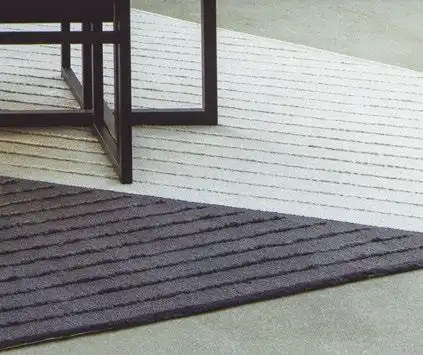
9 minute read
The Lobby
from Sleeper 101
Another Dimension
With the metaverse causing a sensation in the design world, Dubai-based studio Roar has announced its first commercial venture in the virtual realm with the purchase of two plots in Decentraland. The forward-thinking firm plans to develop the plots into a multi-functional space incorporating a furniture showroom, art gallery and an experimental hotel of the future. “The metaverse is clearly a lasting commercial phenomenon, not a passing fad, so we want – and need – to be there,” comments founder and Creative Director, Pallavi Dean. “By launching Roar Meta Space, we’re creating a one-stop-shop to design and develop property in the virtual realm.”
Located close to the fashion district, the plots cost approximately 18,600 Mana – or US$36,000 – and Dean is said to already be in discussions with clients about potential projects. “This is not unchartered territory for us. Designing with AR and VR is second nature, it’s how we work, they’re the tools of our trade. Traditionally, we would hand the designs to engineers and builders to create a physical space – the metaverse simply cuts out that part of the process.”
While Dean believes the metaverse presents the opportunity to work without the two main barriers to creativity in architecture – safety regulations and budget – she stresses that designers cannot lose sight of what’s important – making spaces relatable rather than ultra-futuristic.

© Michel Figuet
Roll Out the Red Carpet
Pierre Yves-Rochon salutes stars of the big screen with two film-inspired suites at Hôtel Martinez in Cannes.
When Hôtel Martinez opened its doors at the height of the Roaring Twenties, it quickly became a popular holiday haunt for the high society, who came to revel in the glitz and glamour of the richly-appointed interiors. Following the launch of Cannes Film Festival in 1946, the hotel’s reputation only amplified, with the Art Deco masterpiece establishing itself as the gateway to the glittering world of movie-making, attracting stars of the silver screen.
Now part of Hyatt’s Unbound Collection, the hotel is celebrating this ongoing affiliation, having tasked Pierre-Yves Rochon with designing two penthouse suites, each dedicated to an eminent figure from French cinema – actress Isabelle Huppert, and Thierry Frémaux, Director of the Cannes Film Festival.
With a sprawling terrace overlooking the French Riviera, the Isabelle Huppert Apartment is decorated in shades of white and gold, with a rich material palette of leather and silk accompanied by bespoke furniture and sumptuous rugs.
For the Thierry Frémaux Apartment, Rochon envisioned a masculine boudoir with a bathroom worthy of A-list status. Decked out in a bold monochromatic colour scheme, the interiors pay homage to the film critic’s impact on the big screen, and feature details such as cinematic film lights and black-and-white tiling that recalls old film reels. And naturally, both apartments come with their own screening room.
Working closely with Rochon, the muses have added their own personal touches too, with decorative objects, books and photographs selected to tell the story. There’s also a bespoke playlist and personalised scent – created in partnership with Mane perfumer Julie Massé – to add to the experience.
Continuing the sensory theme, two-Michelinstarred chef Christian Sinicropi of the hotel’s La Palme d’Or restaurant is set to add an edible element by developing a special menu for the apartments, which will look to capture the cinematic magic of Cannes. Popcorn at the ready.

The Sound of Andaz
Andaz London Liverpool Street is known for its support of the surrounding community, often partnering with local creatives to enhance the guest experience, whether through retail popups, F&B programming or immersive art and design installations. With many endeavours catering to visual, taste and touch senses, the hotel is now turning its attention to sound to forge new connections.
In line with the Andaz ethos – which states ‘we believe that the only true way to embrace a locale is to experience it through every one of the senses’ – the hotel has offered a permanent residency to Hoxton Radio. The alternative radio station for East London covers arts and culture, reflecting the vibrant landscape with cutting-edge new music, emerging trends and local news; its residency will involve live music and DJ sessions each month, as well as regular social media competitions and customised Spotify playlists. There will also be a daily show featuring interviews with guests from emerging neighbourhood lifestyle brands within the realms of F&B, art and culture, and insight from Andaz London’s ambassadors who report weekly on the latest hotel news, keeping guests informed of happenings throughout their stay.
Hoxton Radio’s artists and musicians will perform live on an ad-hoc basis, with guests and locals able to enjoy new talent through free and ticketed events. The station is also managing the DJ calendar at the hotel’s Lounge and Rake’s Café Bar.
The collaboration plays a key role in the ongoing commitment to support the local community. Perfectly aligned with Andaz and its brand values, focused on drawing upon the surrounding neighbourhood and fully immersing guests in the ever-changing and creative culture of Shoreditch, Hoxton Radio’s residency will enable visitors to feel like a true local from the moment they step into the lobby.
More Is More
“I was never trained in painting – nor architecture or interior design – making me an outsider to trades that are now my life’s work,” writes Bill Bensley in the latest addition to his Escapism series. Written by the founder and Creative Director of Bali-based interior design and architecture firm Bensley, with Consultant Editor Suzy Annetta, More Escapism: Hotels, Resorts & Gardens around the World provides behind-thescenes insight into his creative process, as well as exclusive commentary on key design details.
Published by Thames & Hudson, the 512-page hardback monograph features detailed presentations of 12 of Bensley’s most iconic, extravagant and outlandish projects across Southeast Asia, from the jungle hideaway of Capella Ubud, to his own Bensley Collection Shinta Mani Wild in Cambodia. Reflecting his theatrical style, the volume includes 350 photographs with accompanying comments.















With the clock ticking on global climate targets, the hospitality sector doubles down on reducing its carbon emissions.
Words: Ben Thomas As the Paris Agreement’s 2030 target edges closer, pressure is mounting on all industries to come forward with evidence of how they are reducing their carbon emissions.
For hospitality at least, the wheels are already in motion as it journeys towards net zero – a balance between the carbon emitted into the atmosphere and the carbon removed from it.
In West London, Lamington Group recently made history with Room2 Chiswick, a new urban retreat that forecasts using 89% less energy per square-metre than typical UK hotels. The property is also billed as the first globally to account for its entire carbon footprint, meaning both embodied and operational carbon have and will continue to be rebalanced during its lifecycle.
Across the pond in Connecticut, the US’ net zero debut will land this April in the form of Hotel Marcel. Brought to life by architects Becker + Becker and New York-based Dutch East Design, the 165-room property is to become the only one of its kind with both Passive House and LEED Platinum certification, thanks to green energy initiatives like a Power Over Ethernet lighting system, electric vehicle charging and a solar micro-grid that powers the development.
Others are taking the steps needed to help the planet through climate neutral developments, which balance emissions that are naturally absorbed in forests and oceans. Scandic, for instance, is working with construction firm Skanska to create a climate-neutral hotel in Sweden. Slated for completion in 2024, the building will be constructed entirely from wood – its frame, façade and interiors all meet the requirements for LEED Gold certification – while solar panels and energy-efficient practices and will ensure operations are planet-friendly too.
And it’s not just operators committing to reduce their carbon footprint, architecture and design studios are taking action too. After unveiling its Net Zero Carbon interiors pledge – which will see all projects become net zero embodied carbon by 2030 evaluated through a Whole Life Carbon Assessment – Perkins & Will has launched the Now Database, a searchable directory that allows its designers to specify environmentally conscious products. According to the studio’s Sustainability Director Asif Din, the long-term goal is to make the database accessible to the entire supply chain, enabling all those involved to tackle climate change head on. Despite the progress, many remain uncertain of the technical aspects surrounding net zero, such
as what should be included in the GHG Protocol’s Scope 1, 2 and 3 emissions; what milestones need to be reached by 2025, 2030 and 2040 and so on; and how to approach decarbonisation through renewable energy. In response, global sustainable hospitality consultancy Greenview – in partnership with the Sustainable Hospitality Alliance, the World Travel & Tourism Council, Tourism Declares a Climate Emergency, and Pacific Asia Travel Association – has published a free guide documenting practical steps to take.
Developed alongside an Advisory Group of over 20 hotel groups including Marriott, Hilton and IHG, The Net Zero Methodology for Hotels highlights exactly how the challenges faced by the industry can be addressed, as well as providing solutions to help businesses kickstart their journey. So, while lessons will need to be learnt along the way, it’s clear that hospitality is keen to commit to ensure a greener future.










